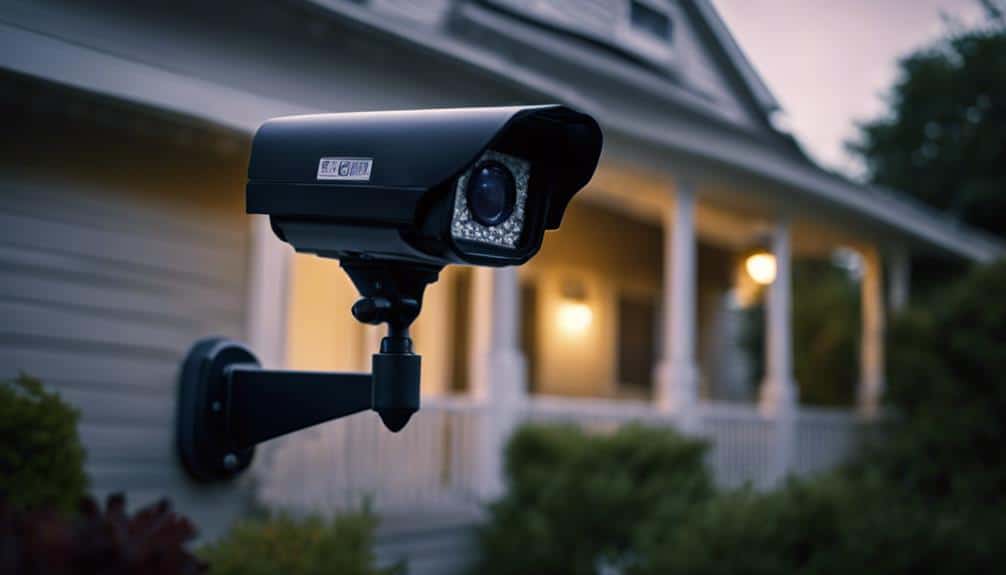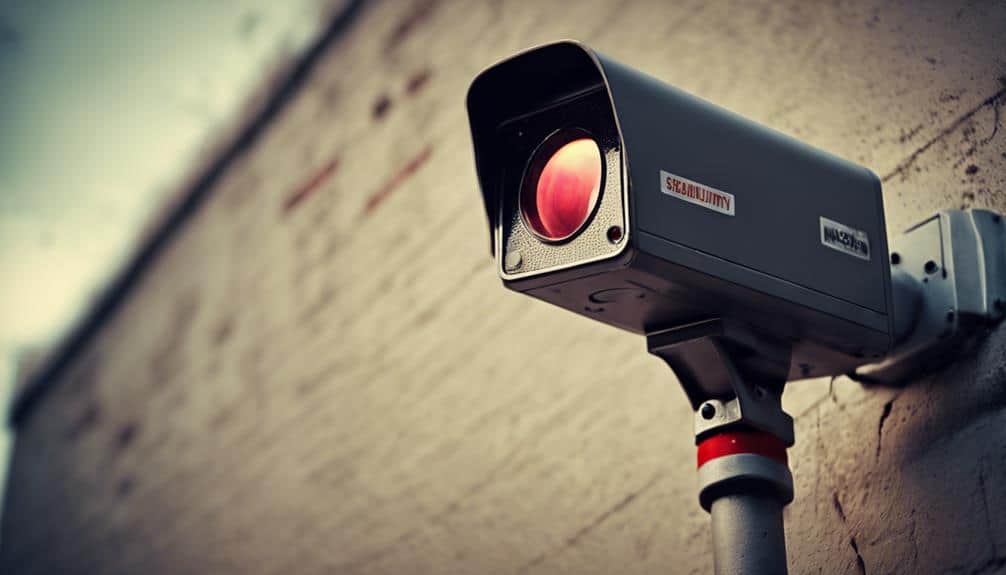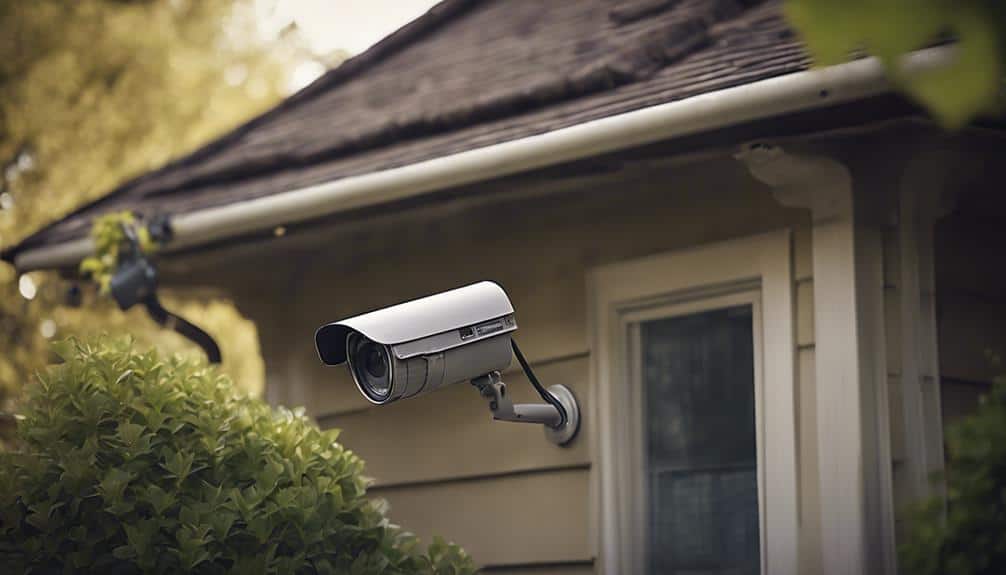Do Fake Security Cameras Deter Thieves?
Fake security cameras can scare off your average porch pirate or would-be thief, making them think twice before striking. They’re a budget-friendly way to boost your home’s security vibe without breaking the bank. The more realistic the camera looks—think blinking lights and motion detectors—the better it works. While seasoned crooks might see through the trick, many opportunistic ones won’t risk it. Just remember, they don’t record anything, so no catching baddies on tape. Don’t let them be your only line of defense. There’s more to the art of keeping your home safe, and you’re just about to discover those secrets.
 Fake security cameras can be a surprisingly effective deterrent against inexperienced or opportunistic criminals. Just imagine, you’re a would-be thief, sneaking around, looking for easy targets. Suddenly, you spot a camera with a blinking red light – yikes! You’d probably think twice, wouldn’t you? That’s the magic of dummy cameras. They create the illusion of surveillance, making it seem like someone’s always watching.
But here’s the kicker: while fake security cameras deter the less experienced, seasoned criminals often see right through them. These pros can recognize fake cameras and might not be scared off. So, while dummy cameras are a cost-effective alternative to real ones, they’re not foolproof. They don’t provide surveillance footage, leaving your valuable items at risk.
Now, let’s talk realism. The more authentic these cameras look – with features like blinking lights, visible wires, or motion sensors – the better their deterrent effect. But beware! Relying solely on fake cameras can give you a false sense of security. It’s essential to pair them with other security measures to truly protect your property. So, don’t get complacent. Stay vigilant and keep those valuable items safe!
Fake security cameras can be a surprisingly effective deterrent against inexperienced or opportunistic criminals. Just imagine, you’re a would-be thief, sneaking around, looking for easy targets. Suddenly, you spot a camera with a blinking red light – yikes! You’d probably think twice, wouldn’t you? That’s the magic of dummy cameras. They create the illusion of surveillance, making it seem like someone’s always watching.
But here’s the kicker: while fake security cameras deter the less experienced, seasoned criminals often see right through them. These pros can recognize fake cameras and might not be scared off. So, while dummy cameras are a cost-effective alternative to real ones, they’re not foolproof. They don’t provide surveillance footage, leaving your valuable items at risk.
Now, let’s talk realism. The more authentic these cameras look – with features like blinking lights, visible wires, or motion sensors – the better their deterrent effect. But beware! Relying solely on fake cameras can give you a false sense of security. It’s essential to pair them with other security measures to truly protect your property. So, don’t get complacent. Stay vigilant and keep those valuable items safe!
 When you see a fake security camera that looks just like the real thing, with its sleek housing and convincing wires, you almost want to believe it’s watching your every move. Adding features like motion alarms and blinking lights can really up the game, making thieves second-guess their choices. But here’s the kicker: if you don’t pick a high-quality one, even the least savvy crook might spot it from a mile away.
When you see a fake security camera that looks just like the real thing, with its sleek housing and convincing wires, you almost want to believe it’s watching your every move. Adding features like motion alarms and blinking lights can really up the game, making thieves second-guess their choices. But here’s the kicker: if you don’t pick a high-quality one, even the least savvy crook might spot it from a mile away.
 Once you’ve navigated the legal considerations, it’s time to focus on the practical aspects of installation and maintenance for fake security cameras. First off, you’ll be pleased to know that fake security cameras are easy to install. Forget about the hassle of wiring or technical setups. Just pick a spot, grab a screwdriver, and you’re good to go!
Strategic placement is key here. You want to install a fake security camera in highly visible areas to maximize their deterrent effect. Think about entrances, driveways, and other spots where thieves might sneak a peek. The more obvious, the better.
Now, let’s talk batteries. Most non-wired dummy cameras operate on batteries, and you’ll find that these batteries last in fake cameras for up to six months. That’s pretty low maintenance, right? Still, don’t forget to do regular inspections. Checking on your fake cameras guarantees they stay in good condition and keep providing valuable deterrence.
Once you’ve navigated the legal considerations, it’s time to focus on the practical aspects of installation and maintenance for fake security cameras. First off, you’ll be pleased to know that fake security cameras are easy to install. Forget about the hassle of wiring or technical setups. Just pick a spot, grab a screwdriver, and you’re good to go!
Strategic placement is key here. You want to install a fake security camera in highly visible areas to maximize their deterrent effect. Think about entrances, driveways, and other spots where thieves might sneak a peek. The more obvious, the better.
Now, let’s talk batteries. Most non-wired dummy cameras operate on batteries, and you’ll find that these batteries last in fake cameras for up to six months. That’s pretty low maintenance, right? Still, don’t forget to do regular inspections. Checking on your fake cameras guarantees they stay in good condition and keep providing valuable deterrence.
Effectiveness of Fake Security Cameras

Benefits and Limitations
Imagine thinking you’ve outsmarted burglars with fake security cameras, only to realize the limitations they bring. Sure, these decoys can scare off casual thieves, saving you some cash, but they won’t catch any real evidence in action. And let’s be honest, seasoned criminals will just laugh and move on, knowing your property isn’t actually protected.Deterring Opportunistic Criminals
Many homeowners find that installing fake security cameras can serve as an effective deterrent against opportunistic criminals. By creating the illusion of surveillance, fake cameras can make would-be thieves think twice before targeting your home. Just imagine a burglar creeping up your driveway, only to spot that ominous lens staring right at them. They’ll likely reconsider and move on, seeking easier prey. For those on a budget, fake cameras offer a cost-effective way to boost home security. They give you peace of mind, allowing you to feel less vulnerable to petty crimes like package theft. These decoys can be especially helpful in neighborhoods where surveillance is rare, making your home appear less appealing to opportunistic criminals. However, it’s important to understand the limitations. While fake cameras may deter some, they don’t provide any actual surveillance or evidence if a crime does occur. This means that if someone does manage to break in, you won’t have any footage to help catch them. Also, seasoned criminals can often spot a fake, reducing the deterrent effect.Lack of Actual Evidence
One major limitation of using fake security cameras is their inability to provide any actual evidence of criminal activity. Imagine finding your shop burgled and realizing there’s no recorded footage to help catch the thief. That’s the harsh reality for many property owners relying on fake security cameras. While these decoys might deter thieves who are just passing by, they fall short when it comes to knowledgeable criminals who can easily spot a fake. Here’s why fake cameras can be problematic:- Lack of recorded footage: Without real surveillance, there’s no way to identify or track down the perpetrator.
- False sense of security: Relying only on fake cameras might make you feel safe, but in reality, you’re still vulnerable.
- Seasoned criminals: Experienced thieves often recognize fake cameras and won’t be deterred.
- No deterrent effect in high-crime areas: In places where crime is rampant, fake cameras are unlikely to fool anyone.
Realism of Fake Cameras

Mimicking Real Camera Appearance
A key to making fake security cameras effective lies in their ability to closely mimic the appearance and function of real cameras. When you install these faux devices, you’re banking on their realistic design to fool potential criminals into believing they’re under proper surveillance. The more your fake cameras look like real ones, the better the deterrence effect. To maximize the realism of your fake surveillance setup, consider these essential features:- Realistic Housing: Choose models with robust, authentic-looking casings and visible wires to mimic a real camera appearance.
- Active Components: Opt for fake cameras with blinking LED lights and motion sensors to simulate active monitoring.
- Movement: Select cameras capable of rotating or appearing to move; this feature can make your setup even more convincing.
- Strategic Placement: Guarantee your fake cameras are installed in highly visible locations to heighten their deterrent effect.
Enhancing Deterrent Features
Building on the importance of mimicking real camera appearance, enhancing the deterrent features of fake security cameras can make an enormous difference in their effectiveness. Think about it: if a fake camera looks convincingly real, it can send potential thieves running in the opposite direction. First, choose high-quality models that come with realistic features like authentic housing, visible wiring, and motion-activated lights. These elements make fake security cameras look like they’re ready to catch any suspicious activity. Adding blinking LEDs and rotating capabilities can also up the ante, simulating active surveillance. Next, don’t forget the power of proper placement. Positioning your fake cameras in high-visibility areas maximizes their perceived security impact. It’s like putting a spotlight on them, saying, “We’re watching you!” Pair these cameras with clear signage indicating their presence. A simple sign stating “24/7 Surveillance” can amplify the illusion of constant monitoring, making would-be intruders think twice.Legal Considerations
Maneuvering the legal landscape of using fake security cameras is essential to avoid potential liabilities. You need to be aware of several key factors to guarantee you’re not crossing any legal lines. First, the placement of fake cameras must comply with CCTV laws, meaning you can’t aim them at private property or windows. This can lead to legal headaches if you’re caught. Property owners also have to display clear signage indicating the presence of cameras. Without these signs, folks might discover the cameras are fake, and you could face legal repercussions. Misleading individuals about security isn’t just bad karma—it can lead to serious legal liabilities. Imagine someone feels secure because of your fake camera, gets into trouble, and then finds out the camera was a hoax. Not good! Here are some key points to keep in mind:- Comply with local laws: Always check your local regulations about surveillance equipment.
- Avoid misleading individuals: Be honest about your security measures to prevent legal issues.
- Clear signage: Make sure you have visible signs indicating camera presence.
- Placement of fake cameras: Guarantee they’re not overlooking private areas to avoid violating CCTV laws.
Installation and Maintenance

Best Practices for Security
Enhancing your security setup isn’t just about using one method: it’s about combining various strategies for maximum effect. Mixing fake security cameras with real security systems, like alarms and motion sensor lights, can create a strong deterrent against thieves. The key is to make everything look seamless and convincing. For instance, incorporating a Solar Powered Dummy Camera can be an energy-efficient way to add realism to your setup. To get the most out of your security setup, consider these best practices:- Placement: Install fake security cameras in visible areas where they’re easily noticed. This makes them seem like part of a thorough surveillance system.
- Signage: Use signs that warn of security cameras. Even if some are fake, the signs amplify their perceived effectiveness and deter criminals.
- Maintenance: Keep fake cameras looking real by regularly cleaning them and updating their appearance. A shabby camera won’t fool anyone!
- Integration: Combine fake cameras with other measures like securing entry points and maintaining clear visibility around your property to enhance overall safety.
Frequently Asked Questions
Do Fake Security Cameras Deter Crime?
You’ll find that fake security cameras’ effectiveness comparison against real ones relies on their psychological impact. They offer cost savings and visual deterrence at strategic installation locations, but neighborhood crime rates and technology advancements demand combined security measures to avoid legal implications.Do Security Camera Signs Deter Thieves?
Imagine your neighborhood watch group installs security camera signs. These visual deterrents boost community safety and property value by creating a strong psychological impact. Surveillance effectiveness and theft statistics show significant crime prevention, enhancing overall security perception.How to Spot a Fake Security Camera?
To spot a fake security camera, check for realistic design and material quality. Inspect motion detection and camera angles. Consider visibility factors and lighting conditions. Technology advancements in real cameras enhance their psychological impact on thieves.Do Burglars Avoid Cameras?
Imagine burglars as mice avoiding traps; their perceptions influence their behavior. Visible cameras enhance psychological deterrence and crime prevention. Effective surveillance technology and smart installation strategies boost neighborhood safety and security awareness, reducing theft motivations.
Facebook
Twitter
LinkedIn
Pinterest
X
Joseph Lombardi
Joseph Lombardi is an esteemed Army combat veteran whose valor and leadership were honed during Operation Iraqi Freedom. His military career is marked by exemplary service and dedication, earning him numerous commendations for bravery and tactical prowess. Transitioning from the battlefield to the business world, Joseph channeled his extensive experience into founding Para Bellum Defense, a premier self-defense products company.
As the owner and CEO of Para Bellum Defense, Joseph brings a unique blend of military discipline and strategic acumen to the forefront of the self-defense industry. His company specializes in innovative and reliable products designed to empower individuals and ensure their safety in an increasingly uncertain world. Under his leadership, Para Bellum Defense has rapidly gained a reputation for excellence, driven by Joseph's unwavering commitment to quality and customer satisfaction.
In addition to his entrepreneurial success, Joseph boasts a decade-long career in executive protection and security. His expert skills in threat assessment, risk management, and personal protection have made him a sought-after professional in the field. Joseph's dedication to safeguarding others extends beyond his professional endeavors, as he actively participates in community outreach programs aimed at promoting safety and self-defense awareness.
With a firm belief in preparedness and empowerment, Joseph Lombardi continues to inspire and protect, embodying the true spirit of a warrior and a guardian.


One Response